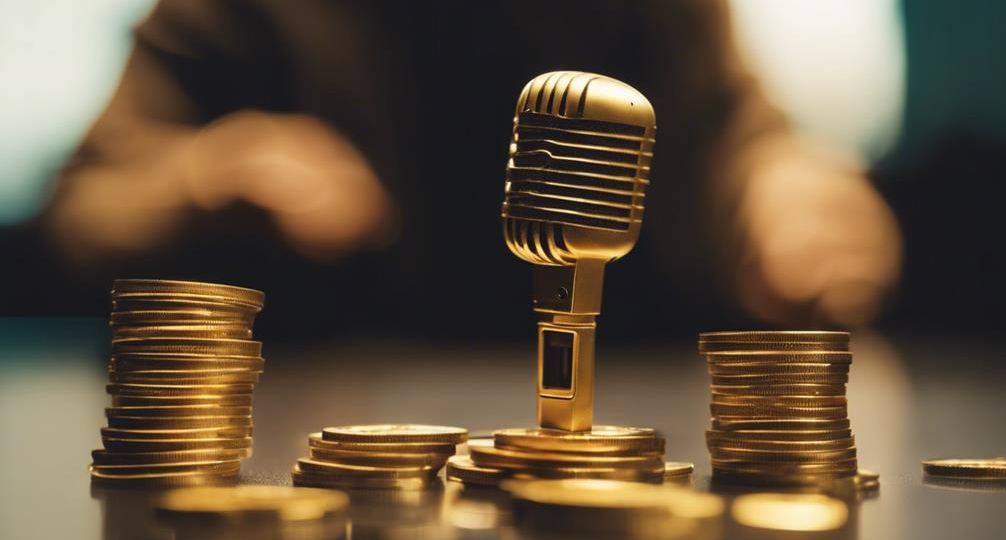
Who is the highest paid Spotify artist?
In 2020, The Weeknd emerged as the highest paid Spotify artist, thanks to his hit ‘Blinding Lights.’ His earnings stem from Spotify’s pro-rata model, where royalties are distributed according to the percentage of total streams. However, the number of streams isn’t the only factor that matters. Record labels, artist contracts, and even methods to prevent stream manipulation play a part in determining who tops the list. Revenue isn’t solely generated from Spotify — artists diversify their income through other platforms and routes like merchandising and performances. There’s more to this intricate web of Spotify’s highest earners if you scratch the surface.
Key Takeaways
- The Weeknd was the highest paid Spotify artist in 2020, largely due to his hit ‘Blinding Lights.
- Artist contracts and record labels greatly influence the revenue distribution from Spotify streams.
- While Spotify’s per-stream rate is lower, its larger user base can lead to higher earnings for popular artists.
- Other income sources like merchandising and performances also contribute to an artist’s total earnings.
- Streaming success and resulting earnings are not determined solely by the number of streams an artist receives.
Understanding Spotify’s Payment Model

Before diving into the details of the highest paid artists, it’s important to understand how Spotify’s payment model actually works. It’s a complex system that’s built on artist royalties and is heavily influenced by subscription impact.
Here’s the rundown: Spotify doesn’t pay artists based on the number of songs they’ve up on the platform. Instead, they use a pro-rata model for distributing royalties. This means that the total revenue Spotify earns from subscriptions and ads is pooled together. After Spotify takes its cut, the remainder is distributed to rights holders, which includes record labels, publishers, and independent artists, based on the percentage of total streams their content represents.
The result? The more subscribers Spotify has, the larger the revenue pool becomes, hence the subscription impact is notable. This model emphasizes the importance of attracting and maintaining a large listener base as it directly impacts artist royalties. It’s a system that continually evolves, aiming to balance the interests of all stakeholders involved.
The Role of Streams in Earnings
When it comes to earnings, the number of streams an artist’s song garners plays a critical role in determining their payout. The more streams a track attracts, the higher the earnings. Yet, it’s not as straightforward as it seems. Factors like stream manipulation and music piracy can skew this equation.
Stream manipulation, often dubbed as ‘fake streams,’ is an unethical practice that inflates stream counts. It’s done via bots or paid-for streams to artificially boost an artist’s popularity, subsequently increasing their earnings. Spotify employs sophisticated algorithms to detect and counter this.
On the other hand, music piracy, while less prevalent in the streaming era, is still a concern. It bypasses the streaming platforms entirely, robbing artists of potential streams and, as a result, revenue.
It’s essential for you, as a music enthusiast, to understand these aspects. Not only does it provide insights into the world of music streaming, but it also emphasizes the importance of ethical listening. By choosing to stream music legally, you’re directly supporting your favorite artists and contributing to a more transparent, fair, and innovative music industry.
Top Five Spotify Earners in 2020

Diving into the financial success stories of 2020, let’s explore the top five Spotify earners, artists who, through their popular tracks, amassed substantial earnings on this streaming platform. The impact of streaming on the music industry is undeniable, and these artists represent the pinnacle of digital music success.
The top earner was The Weeknd, whose hit ‘Blinding Lights’ catapulted him to the top of the charts. Next, we’ve Billie Eilish, whose unique sound garnered her millions of streams. Drake, with his consistent stream of hits, landed in third place. Post Malone’s versatile music style secured him the fourth spot, while Taylor Swift’s loyal fanbase helped her clinch the fifth position.
What’s fascinating isn’t just the figures these artists raked in, but their strategies for income diversification. They’ve leveraged Spotify’s platform, but they’ve also branched out into merchandising, live performances, brand collaborations, and more.
These artists aren’t just musicians; they’re savvy businesspeople who understand the industry’s changing landscape. They recognize the influence of streaming platforms like Spotify and use them to their advantage, making the most of every opportunity to increase their income and reach their fans. This is the new norm in the music industry, and these top earners are leading the way.
How Spotify Payments Compare to Other Platforms
Comparing Spotify’s payment structure to other platforms, it’s evident that each has its own unique model impacting artists’ earnings. It’s not just about the number of streams, but also the diversification of revenue sources and the platform’s payout policy.
Platform comparisons reveal significant differences:
- Apple Music: They pay a penny per stream, which might seem insignificant but accumulates with a large volume of streams.
- Tidal: This platform boasts high fidelity music and pays the highest per-stream rate, making it artist-friendly.
- Amazon Music: Amazon offers different pricing tiers, which can impact an artist’s earnings based on the listener’s subscription level.
- Deezer: A French platform with a user-centric payment system, distributing subscription revenue based on what each user listens to.
These options allow artists to diversify their income sources, an important element in today’s digital music landscape.
While Spotify’s per-stream rate is lower, it boasts a much larger user base, providing potential for more overall earnings.
It’s crucial to understand each platform’s payment structure, ensuring you’re leveraging the best opportunities for revenue diversification.
The Reigning Champion: Highest Paid Artist

In the domain of Spotify streaming, one artist reigns supreme, pocketing more revenue than any other. Yet, it’s not solely about the number of streams. You’ve got to explore deeper, into the world of artist contracts and record labels.
Artist contracts play an important role in dictating the payouts from streaming services like Spotify. The agreement between the artist and their record label determines the percentage of revenue that trickles down to the artist’s pocket. Consequently, even with a high number of streams, an artist with an unfavorable contract mightn’t see the lion’s share of the revenue.
Record labels, on the other hand, have a significant impact on the artist’s exposure and, as a result, their streaming success. A well-networked label can push an artist’s work to a wider audience, leading to a higher number of streams and, in turn, more revenue.

